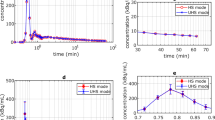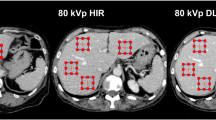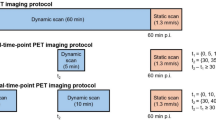Abstract
A helical fan-beam kilovoltage computed tomography (kVCT) was recently introduced into Tomotherapy units. This study aims to share the initial experience of kVCT in clinical workflow, compare its performance with that of the existing megavoltage computed tomography (MVCT), and explore its potential in adaptive planning. We retrospectively enrolled 23 patients who underwent both MVCT and kVCT scans. The clinical performance data regarding image acquisition time, nominal dose length product (DLP), registration time and registration corrections were extracted and compared. Image quality was scored by six experienced radiation therapists and quantified based on phantom measurements. CT number stability and the implementation of adaptive radiotherapy were dosimetrically evaluated by performing the dose recalculation on kVCT. Compared to MVCT, kVCT significantly reduced DLP (except the highest kVp protocol), image acquisition and registration time. KVCT obtained higher scores than MVCT on all criteria except artifacts. Phantom measurements also revealed a better image performance characterization of kVCT except for image uniformity. The CT number variation could lead to a dose difference of 0.5% for D95% of target and Dmean of organ-at-risk. For the treatment planning with kVCT, a systematic dose difference (> 1%) in PTV dose metrics was observed at regions with large longitudinal density discontinuities compared to the reference plans. The new kVCT imaging provides enhanced soft-tissue visualization. The improved efficiency with kVCT-guided treatment will allow more patients to be treated each day. In most cases, the dose calculation accuracy of kVCT images is acceptable except for regions with severe artifacts.





Similar content being viewed by others
References
Alongi F, Fodor A, Maggio A, Cozzarini C, Fiorino C, Broggi S, Alongi P, Calandrino R, Muzio ND (2011) Megavoltage CT images of helical tomotherapy unit for radiation treatment simulation: impact on feasibility of treatment planning in a prostate cancer patient with bilateral femoral prostheses. Tumori 97(2):221–224. https://doi.org/10.1700/667.7787
Aubin M, Morin O, Chen J, Gillis A, Pickett B, Aubry JF, Akazawa C, Speight J, Roach 3 M, Pouliot J (2006) The use of megavoltage cone-beam CT to complement CT for target definition in pelvic radiotherapy in the presence of hip replacement. Br J Radiol 79(947):918–921. https://doi.org/10.1259/bjr/19559792
De Marco P, Abdi Osman I, Castellini F, Ricotti R, Leonardi MC, Miglietta E, Cambria R, Origgi D, Jereczek-Fossa BA, Garibaldi C, Cattani F (2019) Image quality and dose evaluation of MVCT TomoTherapy acquisitions: a phantom study. Phys Med 57:200–206. https://doi.org/10.1016/j.ejmp.2019.01.009
Kilby W, Sage J, Rabett V (2002) Tolerance levels for quality assurance of electron density values generated from CT in radiotherapy treatment planning. Phys Med Biol 47(9):1485–1492. https://doi.org/10.1088/0031-9155/47/9/304
Langen KM, Papanikolaou N, Balog J, Crilly R, Followill D, Goddu SM, Grant 3 W, Olivera G, Ramsey CR, Shi C, Group AT (2010) QA for helical tomotherapy: report of the AAPM Task Group 148. Med Phys 37(9):4817–4853. https://doi.org/10.1118/1.3462971
Mackie TR, Balog J, Ruchala K, Shepard D, Aldridge S, Fitchard E, Reckwerdt P, Olivera G, McNutt T, Mehta M (1999) Tomotherapy. Semin Radiat Oncol 9(1):108–117. https://doi.org/10.1016/s1053-4296(99)80058-7
Meeks SL, Harmon Jr JF, Langen KM, Willoughby TR, Wagner TH, Kupelian PA (2005) Performance characterization of megavoltage computed tomography imaging on a helical tomotherapy unit. Med Phys 32(8):2673–2681. https://doi.org/10.1118/1.1990289
Schulze R, Heil U, Gross D, Bruellmann DD, Dranischnikow E, Schwanecke U, Schoemer E (2011) Artefacts in CBCT: a review. Dentomaxillofac Radiol 40(5):265–273. https://doi.org/10.1259/dmfr/30642039
Smeenk C, Gaede S, Battista JJ (2007) Delineation of moving targets with slow MVCT scans: implications for adaptive non-gated lung tomotherapy. Phys Med Biol 52(4):1119–1134. https://doi.org/10.1088/0031-9155/52/4/017
Velten C, Goddard L, Jeong K, Garg MK, Tome WA (2022) Clinical assessment of a novel ring gantry linear accelerator-mounted helical fan-beam kVCT system. Adv Radiat Oncol 7(2):100862. https://doi.org/10.1016/j.adro.2021.100862
Wagenblast S, Kampfer S, Borm KJ, Combs SE, Pigorsch SU, Duma MN (2019) CT-based dose recalculations in head and neck cancer radiotherapy: comparison of daily dose recalculations to less time-consuming approaches. Strahlenther Onkol 195(6):475–481. https://doi.org/10.1007/s00066-018-1406-z (CT-basierte Dosisneuberechnung bei der Strahlentherapie von Kopf-Hals-Tumoren: Vergleich der taglichen Dosisneuberechnung mit weniger zeitaufwandigen Ansatzen.)
Welsh JS, Patel RR, Ritter MA, Harari PM, Mackie TR, Mehta MP (2002) Helical tomotherapy: an innovative technology and approach to radiation therapy. Technol Cancer Res Treat 1(4):311–316. https://doi.org/10.1177/153303460200100413
Yang C, Liu T, Jennelle RL, Ryu JK, Vijayakumar S, Purdy JA, Chen AM (2010) Utility of megavoltage fan-beam CT for treatment planning in a head-and-neck cancer patient with extensive dental fillings undergoing helical tomotherapy. Med Dosim 35(2):108–114. https://doi.org/10.1016/j.meddos.2009.03.006
Funding
The authors have no funding to disclose.
Author information
Authors and Affiliations
Corresponding author
Ethics declarations
Conflict of interest
The authors have no relevant conflicts of interest to disclose.
Ethical approval
This retrospective study involving human participates was reviewed and approved by HKSH Medical Group Research Committee (RC-2021-24).
Consent to participate
Written informed consent for participation was not required for this study in accordance with the national legislation and the institutional requirements.
Additional information
Publisher’s Note
Springer Nature remains neutral with regard to jurisdictional claims in published maps and institutional affiliations.
Rights and permissions
Springer Nature or its licensor holds exclusive rights to this article under a publishing agreement with the author(s) or other rightsholder(s); author self-archiving of the accepted manuscript version of this article is solely governed by the terms of such publishing agreement and applicable law.
About this article
Cite this article
Yang, B., Geng, H., Chang, T.Y.A. et al. Clinical implementation of kVCT-guided tomotherapy with ClearRT. Phys Eng Sci Med 45, 915–924 (2022). https://doi.org/10.1007/s13246-022-01162-y
Received:
Accepted:
Published:
Issue Date:
DOI: https://doi.org/10.1007/s13246-022-01162-y




